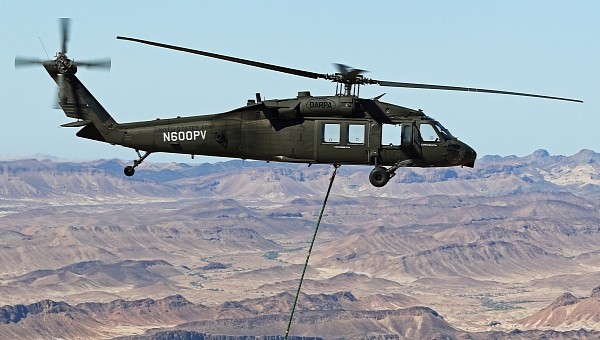Sikorsky and DARPA have demonstrated autonomous mission scenarios with an optionally piloted UH-60A Black Hawk. The helicopter has successfully completed casualty evacuation and medical resupply missions without a pilot or crew onboard.
Sikorsky and the Defense Advanced Research Projects Agency (DARPA) conducted three flights over U.S. Army Yuma Proving Ground with a MATRIX-equipped autonomous Black Hawk aircraft. The helicopter used was optionally piloted, meaning that it could be operated by two pilots, one pilot, or none, depending on the mission requirements.
The three demonstrations were part of the U.S. Army's Project Convergence 2022 (PC22) Technology Gateway exercise, and they took place in mid-October. The uncrewed Black Hawk was capable of carrying a large quantity of blood for over 80 miles (129 km), and it was also able to deliver external cargo and perform a rescue mission.
At first, pilots flew and landed the aircraft, then activated the MATRIX system to give the flight computer complete control. For the long-endurance medical resupply mission, the helicopter had to transport 500 lbs (227 kg) of real and simulated blood. The flight lasted around 50 minutes. During this time, the Black Hawk descended as low as 200 ft (61 m) above ground level through valley terrain to avoid detection.
For the cargo delivery and casualty evacuation missions, it had to take off with a 2,600-lb (1,179 kg) external load attached to a sling and fly at 100 knots (115 mph/ 185 kph) for half an hour toward a designated landing site. After that, it had to transfer a manikin that was secured within the cabin. Next to the manikin's head was a BATDOK tablet, which monitored the health status of the "patient."
These successful missions demonstrate that utility helicopters could one day operate autonomously in contested environments. Sikorsky and DARPA will work to extend the use of this technology for commercial applications, urban air mobility, as well as military missions such as casualty evacuation, medical resupply, and aircrew support.
The three demonstrations were part of the U.S. Army's Project Convergence 2022 (PC22) Technology Gateway exercise, and they took place in mid-October. The uncrewed Black Hawk was capable of carrying a large quantity of blood for over 80 miles (129 km), and it was also able to deliver external cargo and perform a rescue mission.
At first, pilots flew and landed the aircraft, then activated the MATRIX system to give the flight computer complete control. For the long-endurance medical resupply mission, the helicopter had to transport 500 lbs (227 kg) of real and simulated blood. The flight lasted around 50 minutes. During this time, the Black Hawk descended as low as 200 ft (61 m) above ground level through valley terrain to avoid detection.
For the cargo delivery and casualty evacuation missions, it had to take off with a 2,600-lb (1,179 kg) external load attached to a sling and fly at 100 knots (115 mph/ 185 kph) for half an hour toward a designated landing site. After that, it had to transfer a manikin that was secured within the cabin. Next to the manikin's head was a BATDOK tablet, which monitored the health status of the "patient."
These successful missions demonstrate that utility helicopters could one day operate autonomously in contested environments. Sikorsky and DARPA will work to extend the use of this technology for commercial applications, urban air mobility, as well as military missions such as casualty evacuation, medical resupply, and aircrew support.
Soon food, ammunition and medical supplies could all be transported into dangerous airspace by autonomously flown Black Hawks. pic.twitter.com/0RjragNPh8
— Sikorsky (@Sikorsky) November 2, 2022













